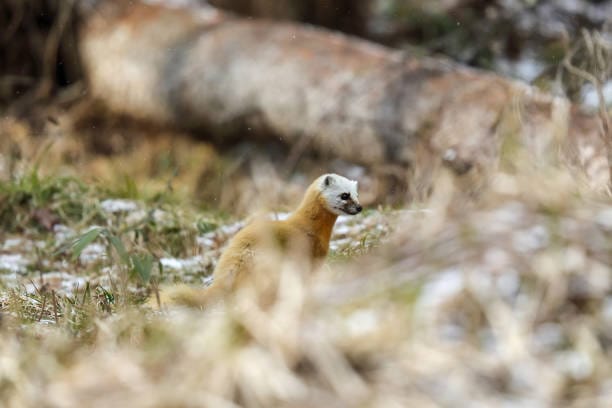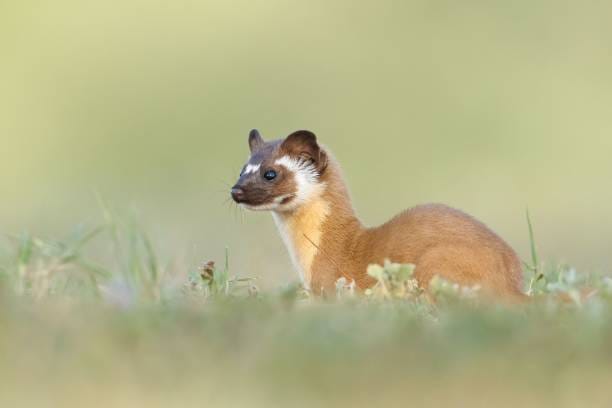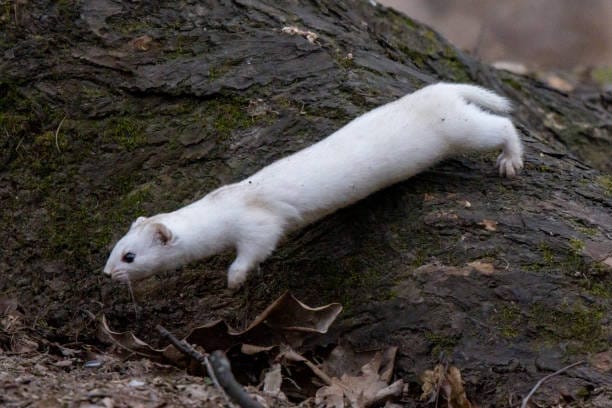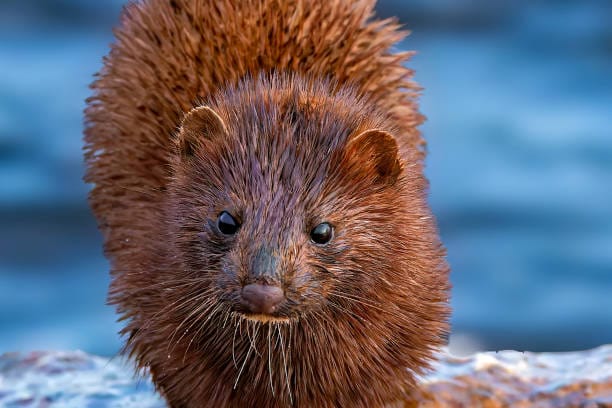Weasels in Maine are small, sleek predators that punch far above their size class. Despite their petite frame, they’re fearless hunters that thrive in forests, wetlands, and even close to human homes. These nimble carnivores belong to the Mustelidae family — a clan that also includes minks, martens, and fishers. In this guide, we’ll explore six types of weasels in Maine, how to identify them, where they live, what they eat, and the fascinating behaviors that make them masters of survival in New England’s wild landscapes.
Whether you’re hiking through Maine’s pine woods or spotting paw prints along a frozen brook, these animals offer a glimpse into one of nature’s most efficient predator designs. So, let’s take a closer look at the weasels that call Maine home — starting with the classic ermine.
1. Short-Tailed Weasel (Ermine) (Mustela richardsonii)

Physical Characteristics & Identification Tips
The short-tailed weasel, often called the ermine, is perhaps the most famous of all Maine’s mustelids. It’s small — typically around 7 to 13 inches long — but its agility and energy are unmatched. During summer, its coat is brown on top and white underneath, but once winter sets in, it transforms into a pure white beauty with a black-tipped tail. This seasonal color change is more than just aesthetic; it’s camouflage perfection, helping the ermine vanish against the snow-covered landscape.
To distinguish it from other weasels, look for the tail length — shorter than the body, with that telltale black tip. Their eyes are large and dark, giving them a wide-eyed, curious expression, though those looks can be deceiving — they’re formidable hunters with needle-sharp teeth and lightning-fast reflexes.
Behavior
Ermines are lively, restless, and always on the move. They seem incapable of sitting still — darting, leaping, and twisting through grass and snow alike. This constant motion isn’t random; it’s how they flush prey from hiding. Despite their size, they’re confident enough to tackle animals larger than themselves, including rabbits. One might even compare their hunting behavior to a “miniature cat on espresso.”
Habitat and Range
Across Maine, ermines thrive in forests, meadows, and even near farms. They prefer areas with plenty of cover — fallen logs, rock walls, and brush piles — that provide both shelter and hunting opportunities. Their range spans across most of North America, but in Maine, they’re especially common in the northern and western regions where winters are long and snow cover deep.
Diet
True to their predatory nature, ermines feed mainly on small mammals such as mice, voles, and shrews. They’ll also take on birds, insects, and occasionally frogs or fish. Their metabolism is rapid, forcing them to eat frequently — a day without food can spell trouble. In that sense, they’re the ultimate opportunists of the forest floor.
Reproduction and Life Cycle
Breeding usually occurs in midsummer, but here’s the twist: implantation of the fertilized egg is delayed until spring, meaning young are born when conditions are favorable. A female ermine gives birth to 4–9 kits in a cozy den lined with fur and leaves. The kits open their eyes around a month old and start learning the art of hunting shortly after — an essential life skill for these tireless predators.
Fun Facts / Traits
- The ermine’s winter coat once symbolized royalty — European nobility wore its fur in coronation robes.
- They sometimes “dance” when excited, performing erratic hops that might look like play but can also confuse prey.
- Despite their size, ermines are capable of taking down prey several times heavier than themselves.
Human Interaction
In Maine, ermines are generally shy and rarely seen. Farmers used to welcome them for keeping rodent populations down, though occasionally, an ermine might steal a chicken or two. Today, they’re admired for their ecological role — small but mighty carnivores maintaining balance in the wild. Spotting one in winter, all white but for that black-tipped tail, feels like catching a glimpse of winter’s own spirit darting through the snow.
2. Long-Tailed Weasel (Neogale frenata)

Physical Characteristics & Identification Tips
If the ermine is Maine’s winter ghost, the long-tailed weasel is its bold cousin — slightly larger, longer, and arguably even feistier. Adults can measure up to 18 inches, with males noticeably bigger than females (a clear case of sexual dimorphism). Their tails make up almost half their body length and end in a dark tip. The coat changes with the season, shifting from brown in summer to a white winter phase in colder regions, though not as consistently as the ermine’s.
The easiest way to identify them is by their proportionally long tail and sleek, muscular build. Their movement is elegant and deliberate — each bound calculated, each twist purposeful. They exude quiet confidence, as if fully aware that their agility gives them the upper hand in nearly any chase.
Behavior
Long-tailed weasels are fierce hunters that rely on stealth and speed. They prefer ambush tactics — slinking close to their prey before delivering a lightning-quick pounce. Don’t let their size fool you: these little predators can dispatch a rabbit or squirrel without hesitation. One might say they hunt with “the heart of a lion packed into a six-ounce body.”
They’re largely solitary and defend their territories aggressively. Each weasel maintains a home range that overlaps slightly with others, but interactions are rare outside of the breeding season. When cornered, they hiss, chatter, and even perform a bizarre, jerky “war dance” — part bluff, part bravado.
Habitat and Range
Long-tailed weasels inhabit nearly every corner of Maine — from coastal thickets to upland woods and farmland edges. They’re remarkably adaptable, living anywhere small mammals abound. They often use abandoned burrows of rodents or dig their own dens under tree roots or brush piles.
Diet
These weasels are carnivores through and through. Their main diet consists of mice, chipmunks, and voles, but they won’t turn down a bird egg or frog. They hunt both day and night, with a preference for dawn and dusk. Interestingly, they sometimes kill more prey than they can eat, storing the surplus for leaner times — an instinctive insurance policy for Maine’s harsh winters.
Reproduction and Life Cycle
Mating happens in summer, yet like their ermine cousins, long-tailed weasels delay implantation until the following spring. This adaptation allows them to give birth in warmer months when food is plentiful. Litters range from 4 to 8 kits, born blind and helpless but growing fast under their mother’s care. By 2 months, they’re miniature versions of adults, already practicing their hunting leaps and pounces.
Fun Facts / Traits
- Long-tailed weasels can climb trees and swim well — impressive for their small stature.
- They use scent glands to mark territory, emitting a musky odor when threatened.
- Despite their reputation as relentless hunters, they’re also playful, often engaging in mock chases and tumbles.
Human Interaction
Farmers in Maine have a mixed relationship with the long-tailed weasel. On one hand, they’re natural pest controllers; on the other, they occasionally raid poultry coops. Still, their value to ecosystems far outweighs the occasional nuisance. Seeing one flash across a dirt road or vanish into tall grass is a rare treat — a reminder of Maine’s wild spirit thriving just beyond our backyards.
3. Least Weasel (Mustela nivalis)

Physical Characteristics & Identification Tips
Meet the smallest carnivore in North America — the least weasel. This tiny predator can weigh less than an ounce, yet it’s pure energy and determination in motion. With a body length of only 6 to 8 inches, the least weasel looks almost toy-like. Its short tail, plain brown upper body, and white underbelly make it distinct from the ermine and long-tailed weasel. Unlike its cousins, its tail lacks a black tip — a simple but reliable field mark.
Don’t underestimate this little creature. Beneath its delicate frame is a ferocious hunter capable of taking prey nearly its own size. Observing one dart through grass or snow is like watching a streak of purpose.
Behavior
The least weasel is bold, curious, and always in motion. It’s known for exploring everything — every hole, every crevice — in pursuit of small mammals. If a mouse is hiding somewhere, a least weasel will find it. They’re primarily diurnal, which means you’re more likely to see them by daylight than most other weasels. But good luck — they move fast, almost serpentine in their agility.
Habitat and Range
In Maine, least weasels are rare and mostly found in the northernmost and upland regions. They favor open meadows, marsh edges, and grassy fields where rodents are plentiful. Though they’re the smallest, they endure Maine’s cold winters surprisingly well, thanks to dense fur and their ability to exploit other animals’ burrows for warmth.
Diet
These tiny predators eat a steady diet of voles, mice, and shrews — sometimes consuming up to 40% of their body weight daily. Their hunting style is relentless: they enter rodent tunnels headfirst and rarely leave without a meal. Occasionally, they’ll stash extra kills, creating miniature “pantries” underground.
Reproduction and Life Cycle
The breeding season for least weasels peaks in spring and summer. Females raise litters of 4–6 kits, born blind and hairless. By six weeks, they’re already practicing hunting techniques through play, mimicking their mother’s movements. Few animals embody survival as intensely as this species — even at a few weeks old, they’re learning to fend for themselves.
Fun Facts / Traits
- The least weasel has the highest surface-area-to-volume ratio of any mammal in Maine — meaning it loses heat quickly and must eat often.
- Its body is so narrow that it can follow a mouse through its own tunnels.
- Despite their tiny size, they occasionally scare away animals much larger than themselves.
Human Interaction
Most Mainers will never see a least weasel — they’re secretive and fast. But their presence benefits local ecosystems, keeping rodent numbers in check. Historically, their small pelts were used in crafts and trimming, though today they’re valued far more as an integral part of Maine’s natural heritage. To spot one in the wild is to witness a marvel of miniaturized efficiency — nature’s smallest but most fearless predator at work.
4. American Mink (Neovison vison)

Physical Characteristics & Identification Tips
The American Mink is a sleek, semi-aquatic member of the weasel family, and perhaps one of Maine’s most recognizable mustelids. Minks have long, slender bodies covered in rich chocolate-brown fur that often gleams in sunlight with a silky sheen. Their small rounded ears, sharp eyes, and slightly webbed feet reveal their amphibious lifestyle. Adults typically measure between 18 to 28 inches, with males noticeably larger than females. A faint white patch under the chin or on the chest is common, but otherwise their coloring is uniform — a useful camouflage along the muddy banks of rivers and ponds.
If you’ve ever seen a small, dark animal dart along a riverbank or swim across a pond with remarkable grace, chances are it was a mink. They move with a combination of stealth and purpose, seamlessly shifting between land and water — true athletes of both elements.
Behavior
Minks are solitary, territorial, and exceptionally skilled hunters. They spend much of their time patrolling the edges of streams and wetlands, searching for food. Though they’re excellent swimmers, they’re equally capable on land, climbing logs or squeezing into burrows to catch prey. Their hunting style is quick and direct — a flash of movement, a splash, and then silence. They rarely waste energy, making them efficient and formidable predators.
Curiously, minks are also playful. They’ve been observed sliding on mud banks, chasing each other through shallow water, or rolling around like otters. It’s as if they’ve found a way to mix business with pleasure in the wild.
Habitat and Range
Maine’s abundance of lakes, rivers, and wetlands makes it prime mink habitat. They’re found throughout the state, from the coastal marshes of York County to the forested streams of Aroostook. Their dens are often tucked into the banks of waterways, hidden among tree roots or under rocks. They prefer clean, slow-moving water — a reliable hunting ground for fish, frogs, and crustaceans.
Diet
As opportunistic carnivores, minks have a varied menu. They feast on fish, frogs, crayfish, mice, and even muskrats. In winter, when waterways freeze, they turn their attention to terrestrial prey such as rabbits and voles. Minks are known to cache surplus food, a smart survival strategy during the harsh Maine winters.
Reproduction and Life Cycle
Breeding occurs in late winter, but like many of their relatives, minks have delayed implantation — the fertilized egg pauses development until spring. This ensures that kits are born when temperatures rise and food is plentiful. A typical litter includes four to six kits, born blind and hairless in a nest lined with grass and fur. By two months, they begin exploring with their mother, learning to hunt and swim — lessons essential to a mink’s life.
Fun Facts / Traits
- Minks have partially webbed feet, allowing them to dive and swim up to 100 feet underwater.
- They can emit a strong musky odor when frightened or marking territory, similar to their skunk cousins.
- Historically, their fur was one of the most prized in North America’s fur trade, symbolizing luxury and warmth.
Human Interaction
While once heavily trapped for their pelts, wild minks in Maine are now more valued for their role in maintaining ecological balance. They help control fish and rodent populations, contributing to healthy aquatic systems. Spotting a mink in the wild is a rare privilege — a flash of brown along the waterline that vanishes as quickly as it appeared. For many Mainers, that glimpse is enough to feel connected to the quiet vitality of their state’s waterways.
5. Fisher (Pekania pennanti)

Physical Characteristics & Identification Tips
The Fisher is often mistaken for a giant weasel or even a small bear cub at a distance. In truth, it’s one of Maine’s most formidable forest predators — sleek, dark, and built for stealth. Adults measure 30 to 47 inches from nose to tail, with males nearly twice the size of females. Their fur is dense and glossy, ranging from dark brown to black, with golden highlights around the neck and shoulders. Their long, bushy tails make up nearly a third of their total length, aiding in balance as they move swiftly through trees.
Despite its name, the Fisher doesn’t eat many fish — its name comes from the French word “fitch,” meaning “polecat.” To identify one, look for a low-slung body, rounded ears, and catlike movement. They’re surprisingly silent for their size, moving like shadows through Maine’s northern woods.
Behavior
Fishers are primarily nocturnal and solitary. They’re incredible climbers, capable of ascending trees headfirst or even climbing down face-first — a rare ability among mammals. While they hunt mainly on the forest floor, they’ll chase prey up trees when needed. Their diet includes squirrels, rabbits, birds, and even porcupines — one of the few animals that can successfully take one down. They accomplish this by circling the porcupine and attacking its unprotected face, a strategy that showcases both intelligence and precision.
Though fierce hunters, fishers also have a softer side. They’re known to groom themselves meticulously, maintain scent-marking routines, and exhibit curiosity when encountering new scents or objects. It’s not hard to imagine them as the secretive guardians of Maine’s forests.
Habitat and Range
Fishers inhabit the vast coniferous and mixed forests of Maine, particularly in areas with dense canopy and fallen logs for cover. They avoid open spaces and urban regions, preferring solitude deep in the wilderness. Their population declined drastically due to over-trapping in the 19th century but has since rebounded thanks to conservation efforts and habitat restoration.
Diet
Fishers are carnivorous generalists — they’ll eat whatever prey is available. Small mammals like snowshoe hares and squirrels form the bulk of their diet, but they also consume carrion, insects, and berries. Their adaptability helps them survive even when food is scarce during long winters.
Reproduction and Life Cycle
Mating occurs in late March or April, with — you guessed it — delayed implantation. Kits are born nearly a year later, usually in hollow trees or log piles. The litter averages two to four young, which remain with the mother until autumn. The young fishers practice climbing and hunting through play, often seen chasing each other up fallen trunks or mock wrestling in soft moss.
Fun Facts / Traits
- Fishers can rotate their hind feet nearly 180 degrees to climb down trees headfirst — an ability shared with very few mammals.
- They’re one of the only predators in North America that regularly hunt porcupines.
- Despite being elusive, they occasionally wander close to rural properties, sparking local folklore about “shadow cats.”
Human Interaction
In Maine, the Fisher has a somewhat mythic reputation — admired, feared, and misunderstood all at once. Farmers respect them for controlling pests but worry about their occasional raids on chicken coops. In reality, such incidents are rare. Most Fishers prefer to remain unseen, slipping through the woods like dark phantoms. For wildlife enthusiasts, catching sight of one is a thrilling reward — proof that Maine’s forests still pulse with untamed life.
6. American Marten (Martes americana)

Physical Characteristics & Identification Tips
The American Marten — sometimes called the Pine Marten — is a small, agile mustelid that looks like a cross between a fox and a ferret. With a slender frame, pointed face, and bushy tail, it’s one of Maine’s most charming forest dwellers. Adults measure about 19 to 25 inches long and weigh between 1 and 3 pounds. Their fur ranges from golden brown to dark chocolate, with a pale or orange-yellow throat patch that gives them a slightly mischievous appearance.
Martens are built for climbing. Their semi-retractable claws, flexible ankles, and long tails allow them to leap gracefully from branch to branch — as if performing a quiet aerial ballet through the spruce and fir canopy.
Behavior
Martens are curious, quick, and highly intelligent. They’re active year-round, hunting both day and night. Unlike the more terrestrial weasels, martens spend much of their time in trees, using their agility to pursue birds and squirrels. They’re also playful creatures, often seen sliding down snowy slopes or tumbling in fresh powder — behavior that feels oddly joyful, as though they take pleasure in life’s small moments.
Habitat and Range
Maine is one of the few eastern states with a healthy marten population. They thrive in the dense northern forests, especially areas with old-growth trees and plenty of hollow logs. Martens are sensitive to habitat disturbance, making them an indicator species for forest health. Their presence signals an ecosystem that’s still intact and thriving.
Diet
Martens have a broad diet that shifts with the seasons. In summer, they eat berries, birds, and insects, while in winter they rely heavily on voles, squirrels, and snowshoe hares. Their adaptability makes them excellent survivors, even when conditions turn harsh. They’re known to store food in tree cavities for later — nature’s version of a pantry in the pines.
Reproduction and Life Cycle
Breeding occurs in midsummer, with implantation delayed until the following spring. Females give birth to two to four kits in early April, usually in a hollow tree or rocky den. The young stay with their mother through summer, learning to climb, hunt, and navigate the forest. By autumn, they disperse to establish their own territories, carrying the next generation of this graceful lineage forward.
Fun Facts / Traits
- Martens can rotate their back legs to descend trees headfirst, like their fisher relatives.
- They’re known for their soft, thick fur — once among the most valuable in the North American fur trade.
- Early settlers referred to them as “tree weasels” for their arboreal habits.
Human Interaction
Today, the American Marten is a conservation success story in Maine. Once nearly trapped out of existence, reintroduction efforts and habitat protections have helped their numbers rebound. Many hikers and trappers now consider the marten a symbol of northern wilderness resilience. Spotting one darting along a snow-laden branch is like seeing a wisp of forest spirit — fleeting, elegant, and full of life.
FAQ’s
1. Are there weasels in Maine?
Yes, Maine is home to several weasel species, primarily the Long-tailed Weasel (Neogale frenata) and the Short-tailed Weasel, also called the Ermine (Mustela erminea). They live in forests, fields, and rural areas across the state.
2. When do weasels breed in Maine?
Weasels in Maine typically breed once a year in late spring. The Short-tailed Weasel has delayed implantation, so babies are usually born in early spring, while the Long-tailed Weasel gives birth about a month after mating.
3. What does a Maine weasel look like?
Maine weasels are small, slender mammals with brown or reddish-brown fur on top and white or cream-colored underparts. In winter, the Short-tailed Weasel may turn completely white, except for a black-tipped tail.
4. How many types of weasel are there?
Worldwide, there are around 17 recognized species of true weasels in the genus Mustela. North America primarily hosts the Long-tailed, Short-tailed (Ermine), and Least Weasel species.
5. What types of weasels live in Maine?
Maine has the Short-tailed Weasel (Ermine) and the Long-tailed Weasel. The Short-tailed Weasel is smaller and more likely to turn white in winter, while the Long-tailed Weasel is slightly larger and maintains its brown coat year-round.
6. What does a Maine mink look like?
The American Mink in Maine has dark brown, glossy fur and a slender body. It has a pointed face, short legs, and a long tail. Minks also usually have small white markings on their chin or throat.
7. How big are minks in Maine?
Maine minks typically weigh between 1.5 and 3 pounds and measure about 18–24 inches long, including the tail. They are larger than weasels and adapted for semi-aquatic life.
8. Are there wild weasels in Maine?
Yes, wild weasels are common in Maine. They are elusive predators that feed on rodents, birds, and insects, helping to maintain a balanced ecosystem.
9. How aggressive are minks?
Minks are very territorial and can be aggressive when cornered or defending their dens. They are skilled hunters and will chase and bite smaller animals if threatened.
10. Are there marmots in Maine?
No, true marmots are not found in Maine. However, groundhogs (also called woodchucks) are relatives of marmots and are common throughout the state.
11. What are the small white weasels in Maine?
Small white weasels in Maine are usually Short-tailed Weasels (Ermines) in their winter coat. Their fur turns white to blend in with the snow, with only the tail tip remaining black.
Conclusion
From the tiny least weasel to the graceful marten, Maine’s mustelids showcase the diversity and adaptability of this incredible family of carnivores. Each species — whether prowling the forest floor, diving through icy streams, or climbing spruce trunks — plays a vital role in maintaining ecological balance. These types of weasels in Maine remind us that size means little in nature; it’s energy, adaptability, and instinct that keep a species thriving.
Next time you wander through Maine’s wilderness, keep an eye on the shadows, the snow tracks, and the rustle under the ferns. Somewhere nearby, a weasel may be watching you first — curious, silent, and perfectly at home in the wild heart of New England.
Read more: 5 Types of Weasels in New York | Identification & Facts
